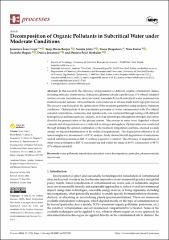Decomposition of Organic Pollutants in Subcritical Water under Moderate Conditions

View/
Date
2024Author
Švarc-Gajić, Jaroslava
Brezo-Borjan, Tanja
Jakšić, Sandra
Despotović, Vesna
Finčur, Nina
Bognar, Szabolcs
Jovanović, Dušica
Šojić Merkulov, Daniela
Metadata
Show full item recordAbstract
In this research, the efficiency of degradation of different organic contaminant classes,
including pesticides (tembotrione, clomazone), pharmaceuticals (ciprofloxacin, 17α-ethinyl estradiol)
and mycotoxins (zearalenone, deoxynivalenol, fumonisin B1) with subcritical water treatment was
studied in model systems. All experiments were conducted in a house-made batch-type pilot reactor.
The research was focused on the optimization of the treatment parameters using moderate treatment
conditions. Optimization of the remediation processes of water contaminated with 17α-ethinyl
estradiol, tembotrione, clomazone, and ciprofloxacin, was conducted through testing with different
homogeneous and heterogeneous catalysts, as well as different gas atmospheres (nitrogen and carbon
dioxide) for pressurization of the process system. Mycotoxins in water were degraded without
catalysts and all experiments were conducted in nitrogen atmosphere. Optimization was conducted
through defining the optimal combination of the treatment temperature and time, oriented towards
energy saving and minimization of the technical requirements. The degradation efficiency in all
tested samples was determined via HPLC analysis. Study showed the full degradation of tembotrione
and all tested mycotoxins at 200 ◦C without a need for a catalyst. The efficiency of degradation of
other tested pollutants at 200 ◦C was satisfying and within the range of 89.5% (clomazone) to 98.7%
(17α-ethinyl estradiol).
